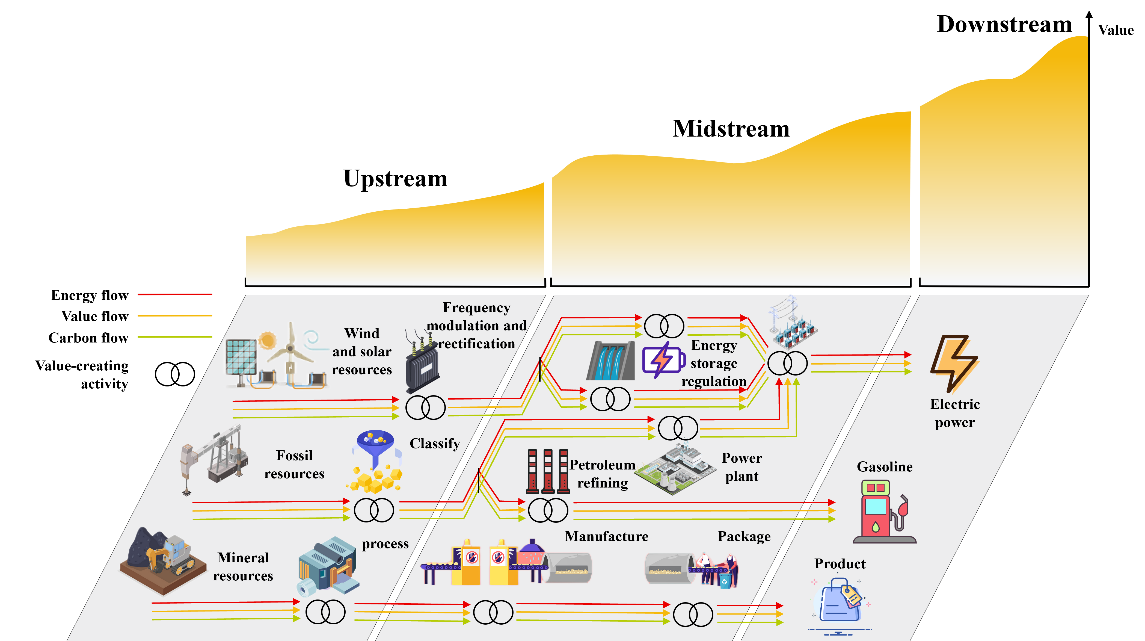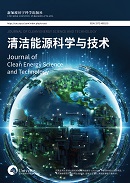能源价值链在碳中和中的作用:综述
DOI:
https://doi.org/10.18686/cncest.v2i4.259关键词:
能源价值链; 能源消耗; 价值创造; 碳排放摘要
价值链分析是企业优化运营和决策的重要工具。随着可持续发展理念在世界范围内得到认可,价值链研究也越来越关注可持续性。传统上,能源管理与价值管理并行不悖,交集有限。然而,自2015年《巴黎协定》提出实现净零排放的目标后,碳管理已成为国家战略不可或缺的一部分,传统价值链需要重新审视。本文引入“能源价值链”这一新概念,将能源消耗与价值创造和碳排放融为一体,强调“能源流”、“价值流”和“碳流”之间的耦合关系。通过对电力、钢铁、石油和交通运输等行业现有价值链的回顾,定义了各行业特定的能源价值链,并讨论了其合理性和有效性。这种集成分析方法为行业或企业优化能源消耗、减少碳排放、增强竞争优势提供了战略工具。

##submission.downloads##
已出版
文章引用
期
栏目
执照
版权声明
##submission.license.cc.by4.footer##参考
1. European Commission. Energy efficiency directive. Available online: https://energy.ec.europa.eu/topics/energy-efficiency/energy-efficiency-targets-directive-and-rules/energy-efficiency-directive_en (accessed on 10 October 2024).
2. 中华人民共和国国家发展和改革委员会. 关于2014年国民经济和社会发展计划执行情况与2015年国民经济和社会发展计划草案的报告. 在线查阅:https://www.gov.cn/xinwen/2015-03/17/content_2835413.htm(2024年10月10日访问).
3. National Development and Reform Commission People’s Republic of China. Report on the Implementation of the 2014 National Economic and Social Development Plan and the Draft Plan for 2015 (Chinese). Available online: https://www.gov.cn/xinwen/2015-03/17/content_2835413.htm (accessed on 10 October 2024).
4. Simens. Simatic Industrial Automation Systems. Available online: https://mall.industry.siemens.com/mall/en/WW/Catalog/Products/5009999 (accessed on 10 October 2024).
5. Schneider Electric. EcoStruxure Platform. Available online: https://www.se.com/ww/en/work/campaign/innovation/platform.jsp (accessed on 10 October 2024).
6. Porter ME. Competitive Advantage: Creating and Sustaining Superior Performance. Free Press; 1985.
7. Masiero G, Ogasavara MH, Jussani AC, et al. The global value chain of electric vehicles: A review of the Japanese, South Korean and Brazilian cases. Renewable and Sustainable Energy Reviews. 2017; 80: 290-296. doi: 10.1016/j.rser.2017.05.148
8. Nauhria Y, Kulkarni MS, Pandey S. Development of Strategic Value Chain Framework for Indian Car Manufacturing Industry. Global Journal of Flexible Systems Management. 2017; 19(S1): 21-40. doi: 10.1007/s40171-017-0179-z
9. European Union. Industrial Development Report 2002/2003: Competing Through Innovation and Learning. European Union; 2004.
10. Wang L, Yue Y, Xie R, et al. How global value chain participation affects China’s energy intensity. Journal of Environmental Management. 2020; 260: 110041. doi: 10.1016/j.jenvman.2019.110041
11. Yao X, Shah WUH, Yasmeen R, et al. The impact of trade on energy efficiency in the global value chain: A simultaneous equation approach. Science of The Total Environment. 2021; 765: 142759. doi: 10.1016/j.scitotenv.2020.142759
12. Yang B, Liu B, Peng J, et al. The impact of the embedded global value chain position on energy-biased technology progress: Evidence from chinas manufacturing. Technology in Society. 2022; 71: 102065. doi: 10.1016/j.techsoc.2022.102065
13. Zhang Z, Li J, Guan D. Value chain carbon footprints of Chinese listed companies. Nature Communications. 2023; 14(1). doi: 10.1038/s41467-023-38479-5
14. Liu C, Zhao G. Can global value chain participation affect embodied carbon emission intensity? Journal of Cleaner Production. 2021; 287: 125069. doi: 10.1016/j.jclepro.2020.125069
15. Zhao G, Liu C. Carbon emission intensity embodied in trade and its driving factors from the perspective of global value chain. Environmental Science and Pollution Research. 2020; 27(25): 32062-32075. doi: 10.1007/s11356-020-09130-3
16. European Union. Ecodesign for sustainable products regulation. Available online: https://commission.europa.eu/energy-climate-change-environment/standards-tools-and-labels/products-labelling-rules-and-requirements/ecodesign-sustainable-products-regulation_en (accessed on 10 October 2024).
17. Dahlström K, Ekins P. Combining economic and environmental dimensions: Value chain analysis of UK iron and steel flows. Ecological Economics. 2006; 58(3): 507-519. doi: 10.1016/j.ecolecon.2005.07.024
18. Mokadmia Z, Rahmounib B. Electric energy value chain in Morocco. Available online: https://www.semanticscholar.org/paper/Electric-Energy-Value-Chain-In-Morocco-MOKADMIa-RAHMOUNIb/41dc6de5411b462c0b3890f660961ffe61046d52 (accessed on 10 October 2024).
19. Breyer C, Tsupari E, Tikka V, et al. Power-to-Gas as an Emerging Profitable Business Through Creating an Integrated Value Chain. Energy Procedia. 2015; 73: 182-189. doi: 10.1016/j.egypro.2015.07.668
20. Hörbe Emanuelsson A, Johnsson F. The Cost to Consumers of Carbon Capture and Storage—A Product Value Chain Analysis. Energies. 2023; 16(20): 7113. doi: 10.3390/en16207113
21. Attias D (editor). The Automobile Revolution: Towards A New Electro-Mobility Paradigm. Springer; 2016.
22. Jarvis SM, Samsatli S. Technologies and infrastructures underpinning future CO2 value chains: A comprehensive review and comparative analysis. Renewable and Sustainable Energy Reviews. 2018; 85: 46-68. doi: 10.1016/j.rser.2018.01.007
23. Wu G, Pu Y, Shu T. Features and evolution of global energy trade network based on domestic value-added decomposition of export. Energy. 2021; 228: 120486. doi: 10.1016/j.energy.2021.120486
24. Munasinghe M, Jayasinghe P, Ralapanawe V, et al. Supply/value chain analysis of carbon and energy footprint of garment manufacturing in Sri Lanka. Sustainable Production and Consumption. 2016; 5: 51-64. doi: 10.1016/j.spc.2015.12.001
25. Liu H, Li J, Long H, et al. Promoting energy and environmental efficiency within a positive feedback loop: Insights from global value chain. Energy Policy. 2018; 121: 175-184. doi: 10.1016/j.enpol.2018.06.024
26. Guan D, Meng J, Reiner DM, et al. Structural decline in China’s CO2 emissions through transitions in industry and energy systems. Nature Geoscience. 2018; 11(8): 551-555. doi: 10.1038/s41561-018-0161-1
27. Cai Y, Qian X, Nadeem M, et al. Tracing carbon emissions convergence along the way to participate in global value chains: A spatial econometric approach for emerging market countries. Frontiers in Environmental Science. 2022; 10. doi: 10.3389/fenvs.2022.1039620
28. Gamarra AR, Lechón Y, Escribano G, et al. Assessing dependence and governance as value chain risks: Natural gas versus concentrated solar power plants in Mexico. Environmental Impact Assessment Review. 2022; 93: 106708. doi: 10.1016/j.eiar.2021.106708
29. Pan L, Liu P, Li Z. A system dynamic analysis of China’s oil supply chain: Over-capacity and energy security issues. Applied Energy. 2017; 188: 508-520. doi: 10.1016/j.apenergy.2016.12.036
30. Fennell P, Driver J, Bataille C, et al. Cement and steel—Nine steps to net zero. Nature. 2022; 603(7902): 574-577. doi: 10.1038/d41586-022-00758-4
31. Smith R, MacGill I. The great rebalancing: Rattling the electricity value chain from behind the meter. In: Sioshansi FP (editor). Innovation and Disruption at the Grid’s Edge: How Distributed Energy Resources are Disrupting the Utility Business Model. Elsevier; 2017. pp. 41-64. doi: 10.1016/b978-0-12-811758-3.00003-6
32. Peng J, Wen L, Xiao J, et al. Industrial Chain, Supply Chain and Value Chain in the Energy Industry: Opportunities and Challenges. MDPI; 2024. doi: 10.3390/books978-3-7258-1200-4
33. Gert B, Marius B, Anna P. Regulatory and institutional aspects of smart grids. In: Van Dinther C, Flath CM, Madlener R (editors). Smart Grid Economics and Management. Springer; 2022. pp. 107-135.
34. van Dinther C, Flath CM, Madlener R, et al. Smart Grid Economics and Management. Springer International Publishing; 2022. doi: 10.1007/978-3-030-84286-4
35. Park C, Heo W. Review of the changing electricity industry value chain in the ICT convergence era. Journal of Cleaner Production. 2020; 258: 120743. doi: 10.1016/j.jclepro.2020.120743
36. Stapczynski S. Blockchain, drones are strategies for survival at Japan’s Tepco. Available online: https://www.bloomberg.com/news/articles/2018-01-09/blockchain-drones-are-strategies-for-survival-at-japan-s-tepco (accessed on 10 October 2024).
37. Appelrath HJ, Kagermann H, Mayer C, et al. Future Energy Grid. Springer Berlin Heidelberg; 2012. doi: 10.1007/978-3-642-27864-8
38. Wang RQ, Jiang L, Wang YD, et al. Energy saving technologies and mass-thermal network optimization for decarbonized iron and steel industry: A review. Journal of Cleaner Production. 2020; 274: 122997. doi: 10.1016/j.jclepro.2020.122997
39. Ghazinoory S, Fatemi M, Adab A. Iranian steel value chain: Advantageous but unsustainable. Clean Technologies and Environmental Policy. 2022; 24(7): 2099-2115. doi: 10.1007/s10098-022-02300-6
40. Conejo AN, Birat JP, Dutta A. A review of the current environmental challenges of the steel industry and its value chain. Journal of Environmental Management. 2020; 259: 109782. doi: 10.1016/j.jenvman.2019.109782
41. Panasiyk D, Laratte B, Remy S. Steel Stock Analysis in Europe from 1945 to 2013. Procedia CIRP. 2016; 48: 348-351. doi: 10.1016/j.procir.2016.04.084
42. Michaelis P, Jackson T. Material and energy flow through the UK iron and steel sector. Part 1: 1954-1994. Resources, Conservation and Recycling. 2000; 29(1-2): 131-156. doi: 10.1016/S0921-3449(00)00048-3
43. Michaelis P, Jackson T. Material and energy flow through the UK iron and steel sector: Part 2: 1994-2019. Resources, Conservation and Recycling. 2000; 29(3): 209-230. doi: 10.1016/S0921-3449(00)00041-0
44. Peng J, Xie R, Lai M. Energy-related CO2 emissions in the China’s iron and steel industry: A global supply chain analysis. Resources, Conservation and Recycling. 2018; 129: 392-401. doi: 10.1016/j.resconrec.2016.09.019
45. Ahmad NKW, de Brito MP, Rezaei J, et al. An integrative framework for sustainable supply chain management practices in the oil and gas industry. Journal of Environmental Planning and Management. 2016; 60(4): 577-601. doi: 10.1080/09640568.2016.1178105
46. Hunt JD, Nascimento A, Nascimento N, et al. Possible pathways for oil and gas companies in a sustainable future: From the perspective of a hydrogen economy. Renewable and Sustainable Energy Reviews. 2022; 160: 112291. doi: 10.1016/j.rser.2022.112291
47. Nurdiawati A, Urban F. Decarbonising the refinery sector: A socio-technical analysis of advanced biofuels, green hydrogen and carbon capture and storage developments in Sweden. Energy Research & Social Science. 2022; 84: 102358. doi: 10.1016/j.erss.2021.102358
48. Ramos G. Decarbonization for Oil and Gas Value Chain: An Update Review. Angolan Industry and Chemical Engineering Journal. 2021; 1(1). doi: 10.47444/aincej.v1i1.5
49. Nabati H, Fard MB. Production as a source of competitive advantage in the value chain of electrified heavy vehicles manufacturing companies. Available online: https://www.diva-portal.org/smash/get/diva2:1601129/FULLTEXT01.pdf (accessed on 10 October 2024).
50. Salimi M, Hosseinpour M, Borhani TN. The role of clean hydrogen value chain in a successful energy transition of Japan. Energies. 2022; 15(16): 6064. doi: 10.3390/en15166064
51. Arfan M, Wang Z, Soam S, et al. Biogas as a Transport Fuel—A System Analysis of Value Chain Development in a Swedish Context. Sustainability. 2021; 13(8): 4560. doi: 10.3390/su13084560
52. Worldsteel Association. Energy use in the steel industry. Available online: https://worldsteel.org/wp-content/uploads/Fact-sheet-Energy-use-in-the-steel-industry.pdf (accessed on 10 October 2024).
53. 魏佳琪. 油气行业低碳发展的必然选择——生产用能电气化. 在线查阅:http://www.sinopecnews.com.cn/xnews/content/2023-08/07/content_7072863.html (2024年10月10日访问).
54. Wei J. The inevitable choice for low-carbon development in the oil and gas industry: Electrification of energy use in production (Chinese). Available online: http://www.sinopecnews.com.cn/xnews/content/2023-08/07/content_7072863.html (accessed on 10 October 2024).
55. Ritchie H. Tracking global data on electric vehicles. Available online: https://ourworldindata.org/electric-car-sales (accessed on 10 October 2024).
56. Low J. Global EV market forecasted to reach 17.5 million units with solid growth of 27% in 2024. Available online: https://www.canalys.com/newsroom/global-ev-market-2024 (accessed on 10 October 2024).
57. Ritchie H, Rosado P. 30% of the world’s electricity came from renewable sources in 2023. Available online: https://ourworldindata.org/data-insights/renewable-electricity-2023 (accessed on 10 October 2024).




